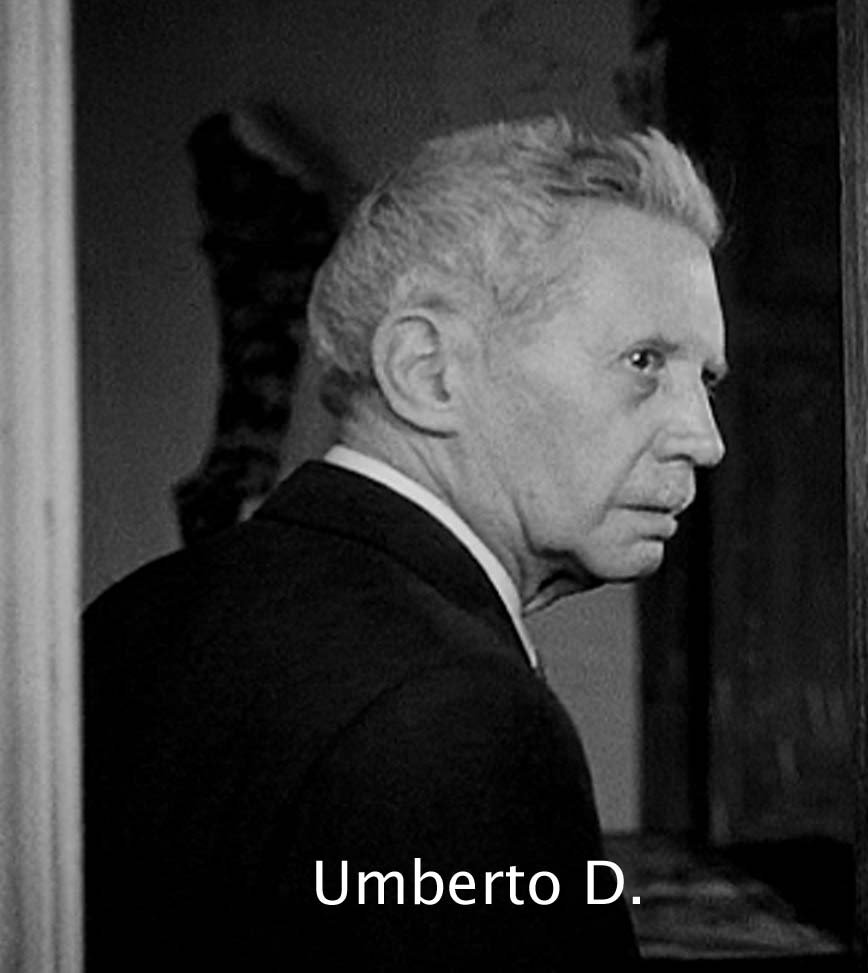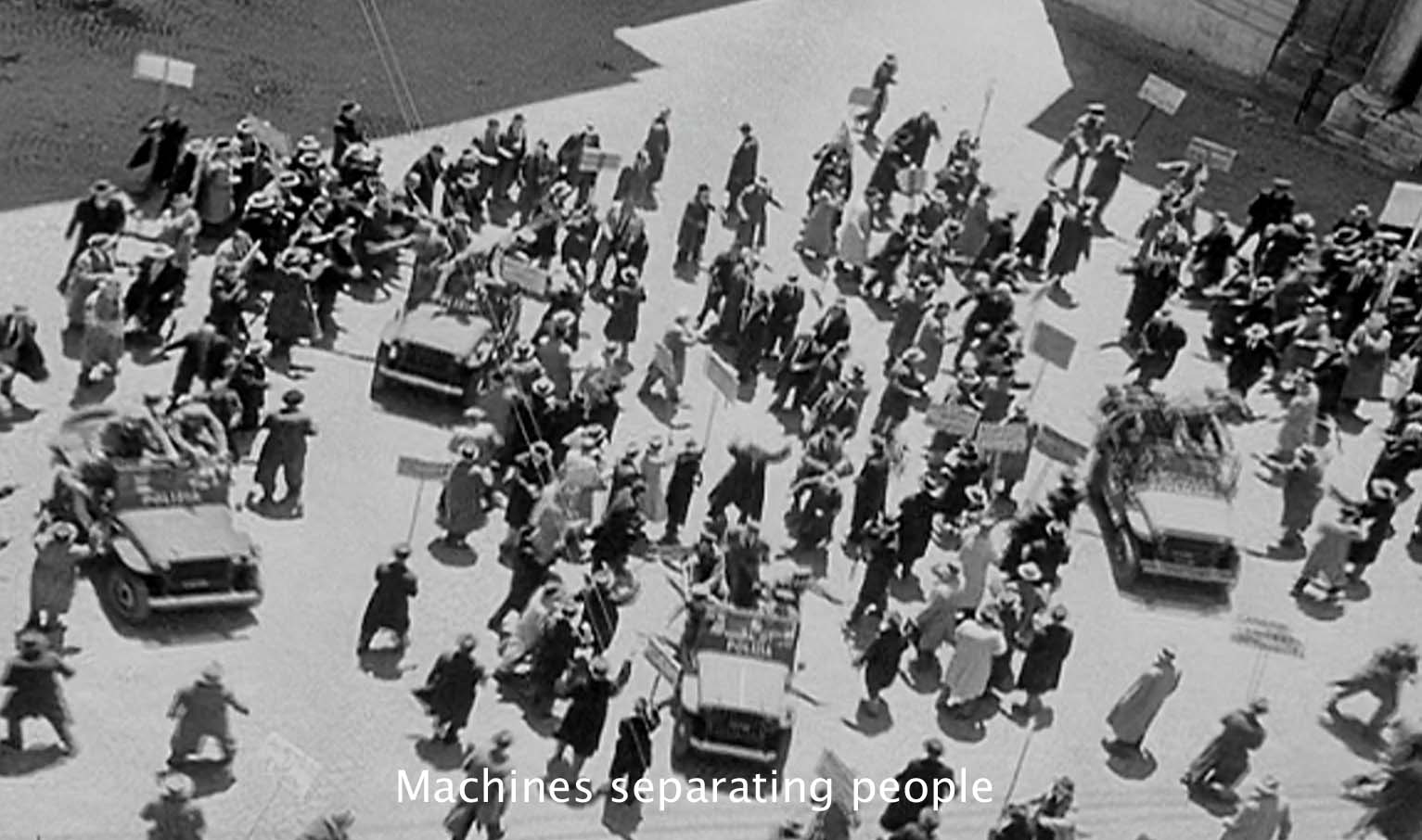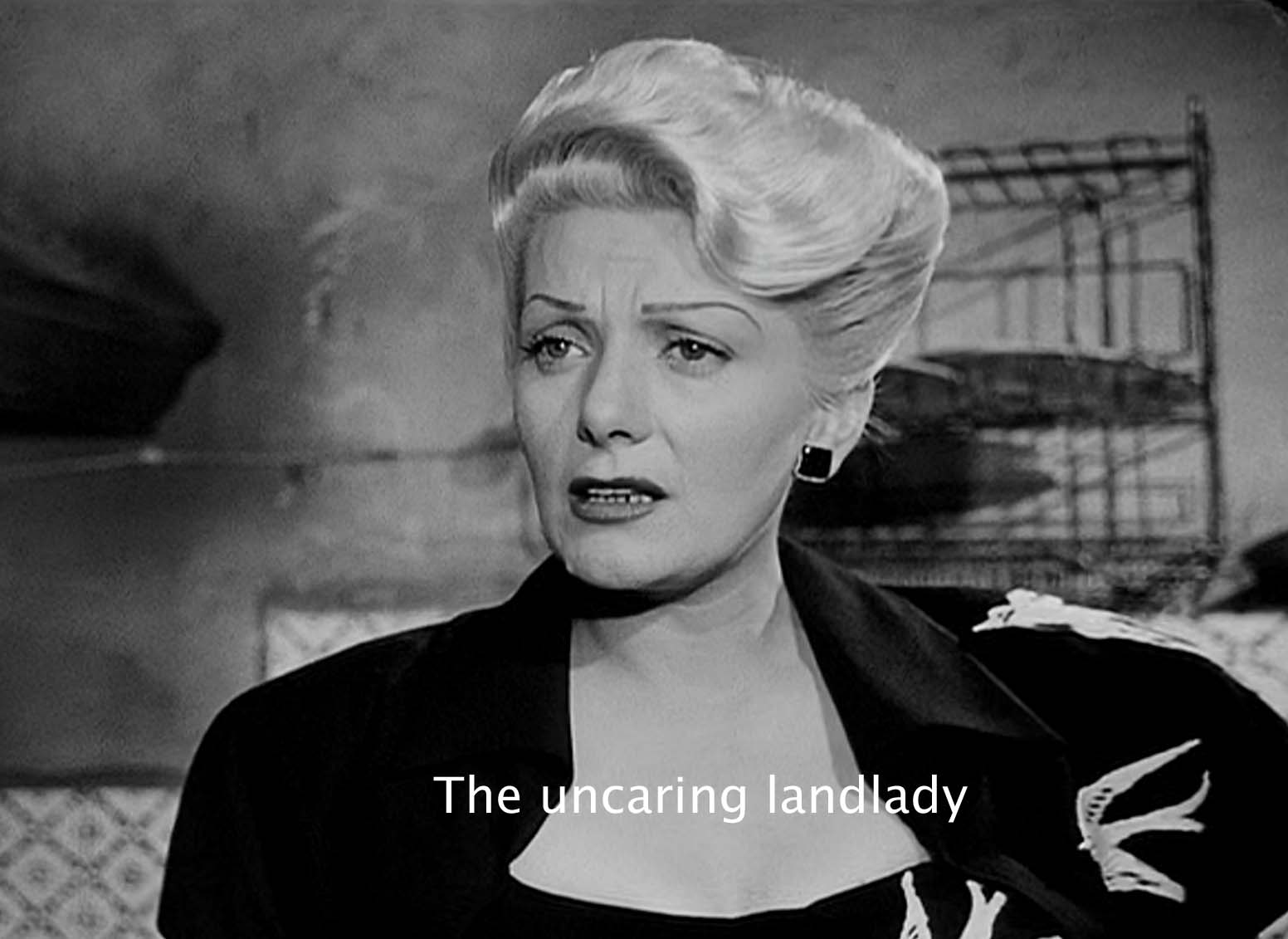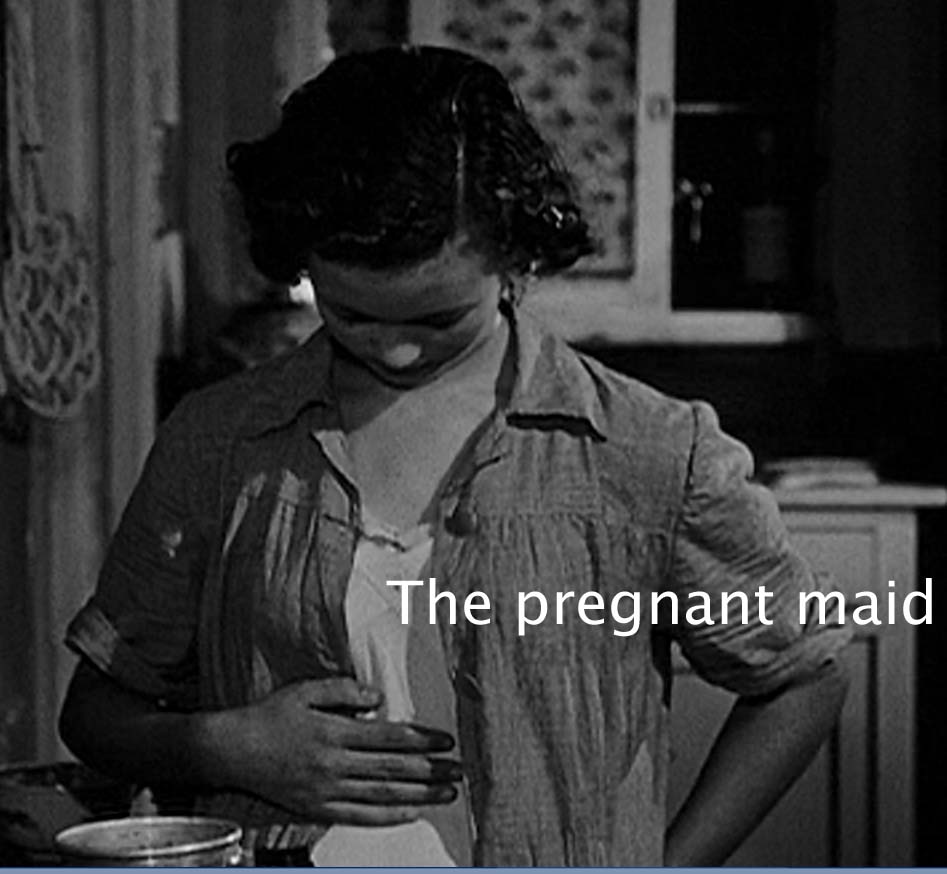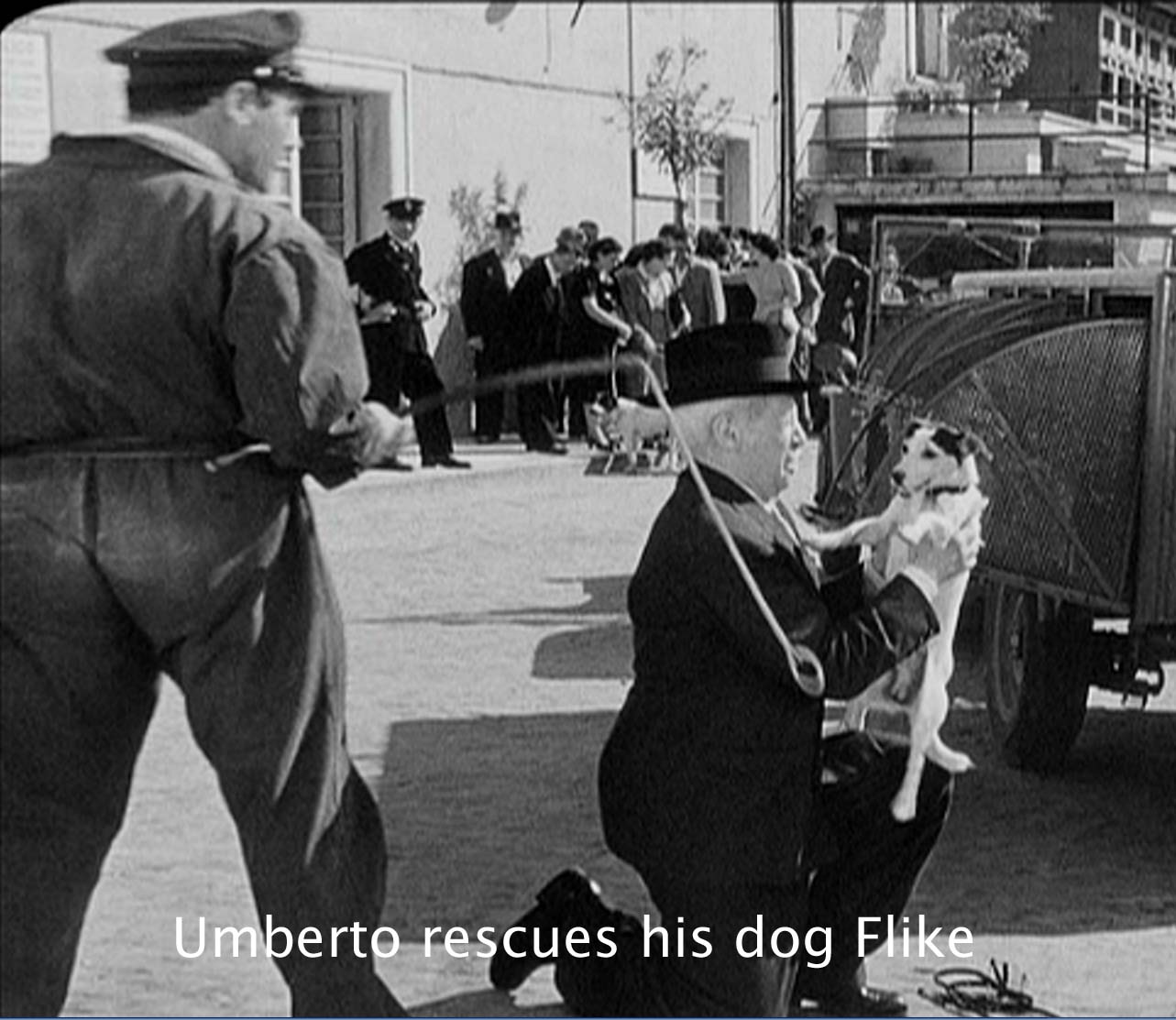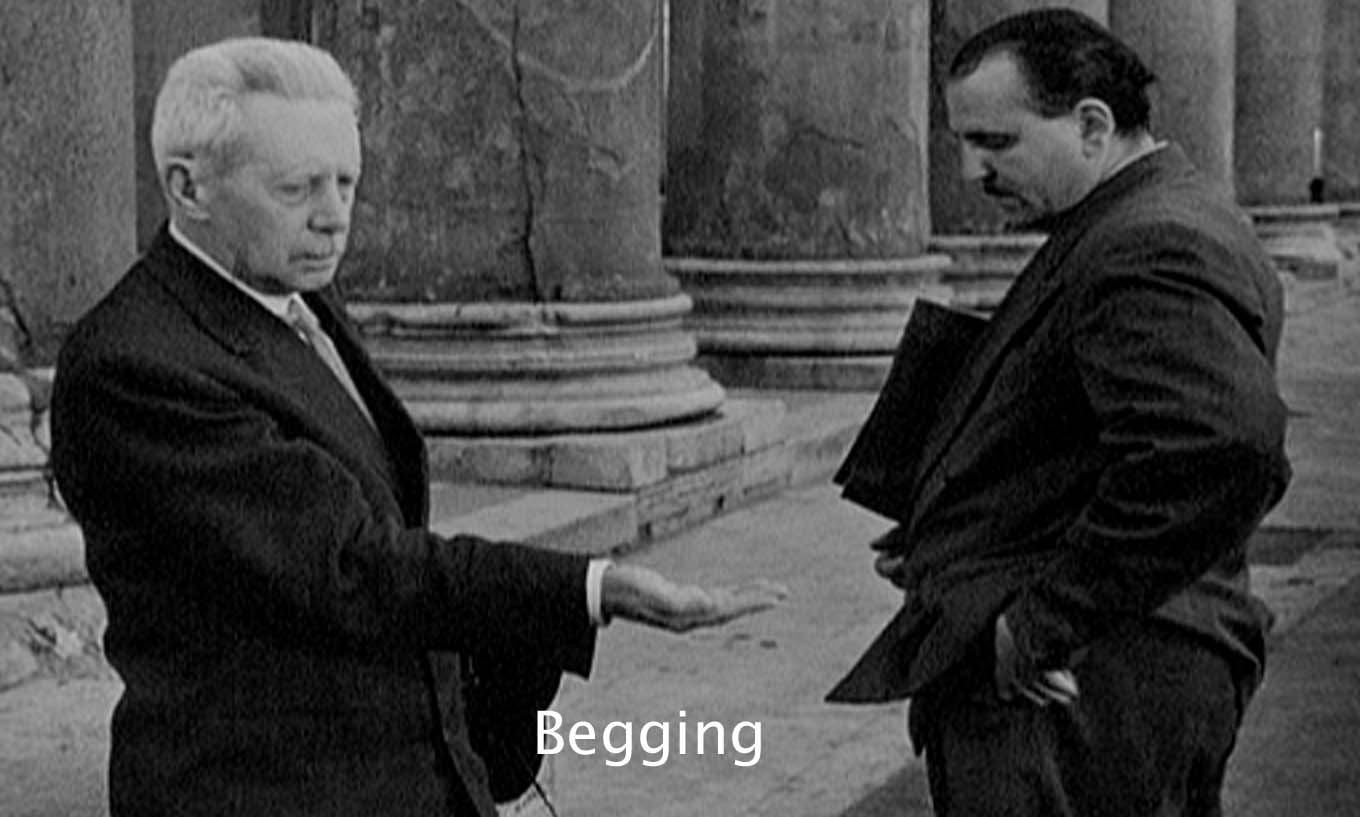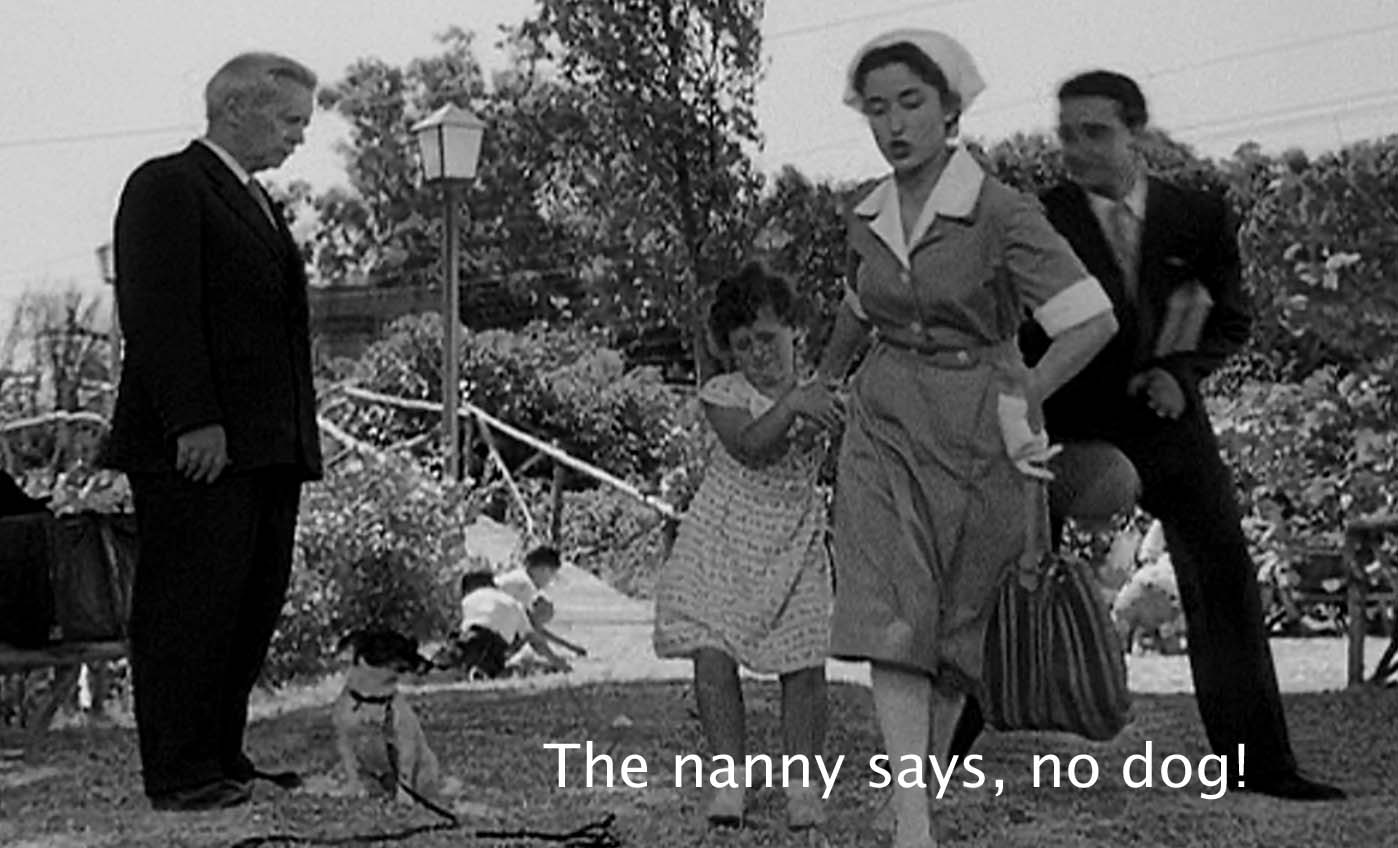The chief actors were non-professionals, picked out by De Sica almost at random. This film is classic Italian neo-realism. The old man who is Umberto D. or Umberto Domenico Ferrari, the protagonist, is played by Carlo Battisti, a professor of linguistics who couldn’t remember his lines and whom De Sica found on the street. His one human friend is a maidservant played by a 15-year-old schoolgirl (Maria Pia Casilio). Her he found in the balcony watching others audition for the part. She went on to make other movies; Battisti did not. His great achievement was the Etymological Dictionary of the Italian Language.
The one professional in a major role is the dog Flike or “Toby,” played by a trained dog named Napoleone.
The film departs from neo-realism in making Umberto D. middle-class, and the old man tries very hard to keep up his bourgeois pretensions. Unlike the victim-heroes in Shoeshine and Bicycle Thieves, he is a crusty old guy who can be quite nasty. As De Sica says, “He is good only to the good, and extremely disagreeable to those who are not good to him.”
But very much in the neo-realist manner the camera lingers on bits of ordinary life— the maidservant’s morning routine; walkers in the street, a bus preparing to depart, or people in a park—to the point where these seem shot in real time. Stuart Klawans has called this “the cinema of steady gaze.” And, like other neo-realist movies, the plot is minimal and the ending inconclusive.
An old man, Umberto D., and his dog Flike live in one room of a larger apartment owned by a flashy and cruel middle-aged woman, a singer (played by Lina Gennari, a professional actor). She wants to evict the old man so that she can make more money by renting the room by the hour to couples looking for someplace to have sex. At the same time, she is trying to marry a wealthy suitor.
One person befriends the old man, her maidservant who has to sleep on a cot in the hall in the apartment. She, poor soul, is pregnant by one or the other of two soldiers who have no intention of marrying her. The pensioner, bourgeois to the core, is at first not sympathetic.
He tries various ways to find the rent money and to care for his dog. He tries to beg, he approaches richer friends, he sells his watch, he tries to find Flike a home with someone else. Finally, he gives up. Defeated by the landlady, he slinks away from his apartment and the one person with whom he has a relationship, the maid. He tries to give the dog away to a little girl, but a harsh governess stops that. He even attempts a joint suicide with the dog. All his efforts fail, and the film ends in the best neo-realistic manner: Umberto D. and Flike walk out of the film frame toward an uncertain and probably miserable future as a street person. (Some of my colleagues in the local Film Club, however, read the ending as optimistic: he has shed his hopeless past.)
Brilliant as it is, Umberto D. failed at the box office, despite winning the New York Film Critics’ Circle Award for Best Foreign Film and being nominated for the Grand Prize of the Festival at Cannes, as well as other awards from Denmark and Finland. It was nominated for the Oscar for Best Writing in the U.S., honoring De Sica’s noted and talented collaborator, Cesare Zavattini. But various troubles with producers and distributors made it flop financially. The film got vicious criticism from Giulio Andreotti, in charge of Italy’s movie production and later prime minister. And the Communist party attacked the film. Umberto D.’s flop may have been what finished off the neo-realism movement.
There is no cheer in this film. It is hard to imagine a more gloomy movie. De Sica has written of it: “What is the meaning of the film? It seeks to put on the screen the drama of man’s inability to communicate with his fellow man.” “Men do not communicate with each other; how then can they communicate with Umberto?” “Inability to communicate”—that’s a cliché of culturetalk. I have to assume that De Sica means much more by “communicate” than just people talking to each other. I think he means the ability to love or to care for or simply to be close to someone. And that doesn’t happen in this film, except for Umberto D. and his dog.
As De Sica works out this theme, the dominant image in his film becomes people (or animals) separating from one another.
- the opening sequence, the police dispersing the pensioners’ protest and the old men’s turning against their leaders;
- the way the landlady scorns her tenant and her maid and has as little as possible to do with them;
- the lovers who had been using Umberto’s room breaking up
- the soldiers leaving their base;
- Maria dispersing the ants (!)
- a solitary cat crossing a skylight;
- a sequence where Umberto is holding out his hand as if to beg, but then, a true bourgeois, he rejects a man about to give him money;
- guests noisily leaving the landlady’s party, caring nothing for the person trying to sleep whom they are disturbing;
- the friends whom the old man approaches who chat him up but go on their way and leave him standing there, penniless
- the long, long shot of him leaving his old neighborhood on a bus;
- the governess who sweeps the little girl away in the park;
- the old man’s futile attempt to leave the dog followed by his abortive try to have both him and Flike run over by a train;
- the final shot of Umberto and Flike disappearing in the distance.
Often, machines are what separates people: the police cars that break up the pensioners’ demonstration; busses that take Umberto’s false friends away; the ambulance that drives between him and his hospital buddy, and, of course, the train that nearly kills Umberto and Flike.
One scene (among many) encapsulates the motif of this movie. In the park, near the end, the old man tries to give Flike to a little girl who would be delighted to have him. But her governess and the governess’ boyfriend pull her away, saying the dog would be too much trouble. Their laziness or low desires trump any caring for either the old man, the dog, or the little girl.
The last shot of the film shows the old man and Flike wandering off in the background, their future zero. In the foreground a pack of joyful children run in a bunch. It is as though we can only truly be together and loving when we are children. Adults are too caught up in their own greed and lust.
That is why, I think, another motif in the film is illicit sex. (It’s not just my dirty mind.) The soldiers have gotten the maid pregnant. The landlady rents out Umberto’s room to adulterous couples when he is not there. The landlady is doing god knows what at her first party, but a couple of shots show how she is holding out on her suitor to make sure he marries her. Adult desires, be they for sex or money, outweigh humans’ decency to one another.
The arts might inspire people to do better. But the arts, as represented by the landlady’s singing, only further embody people’s shabby ambitions. People just don’t give a damn about other people (or dogs) if they interfere with the universal search for sex, profit, or just ease. As De Sica has written, “There is a little of this landlady in all of us!”
In many ways, Umberto D. is the best, the richest and most penetrating of all the neo-realistic films. It is classic Italian neo-realism with all the extraordinary lifelikeness of that genre. But it also goes beyond realism toward a sweeping and deeply discouraging view of humanity. If the best model we have for what human relations should be is the love of a dog for his master or the love of an old man for his dog, what does that say about human relationships? Nothing good.
Nevertheless, in 1968, De Sica wrote, “Umberto D. is the film that I prefer among all those I have made” (this, despite his normally sunny disposition). I would agree—despite my own normally sunny disposition. I think it one of the most profound and moving experiences movies have to offer.
